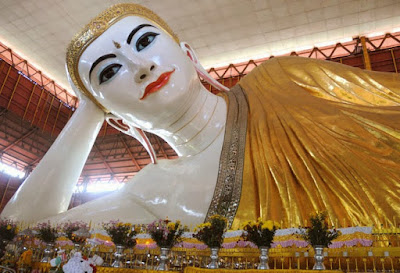Dhr. Seven, Amber Larson, Ashley Wells, CC Liu, Wisdom Quarterly
 |
| There is suffering of all kinds. I teach the path to the end of all suffering (Sukhothai). |
.
 In the Buddha's day with its lunar Indian calendar, this time of year (roughly corresponding to moving dates falling within April-May on the modern Western calendar) is called the month of VESAK.
In the Buddha's day with its lunar Indian calendar, this time of year (roughly corresponding to moving dates falling within April-May on the modern Western calendar) is called the month of VESAK. |
| Born in Central Asia not Nepal or India |
It is a three times blessed month because on the full moon night of Vesak an estimated 2600 years ago, Prince Siddhartha Gautama was born outside of India [probably in Bamiyan, Afghanistan but certainly not Nepal as popularly reported; see ranajitpal.com for controversy].
 |
| I'll always remember you, dear Kanthaka! |
He would renounce the world (and the royal palace, and his kingdom, and his princess wife, and his princely newborn, and his beloved white pony Kanthaka, and the only life he had known, one of great comfort and prestige) 29 years later and within 7 years of that attain supreme enlightenment (maha-bodhi). It was the culmination of many lives' effort.
 |
| His skin became brilliant wearing a golden robe gifted to him reclining into final nirvana |
.
Then, miraculous event after miraculous event, 45 years after that -- on the full moon night of Vesak -- the Buddha reclined into final nirvana, the culmination of all the effort put forward to achieve what is nearly impossible to achieve: the attainment of sammasambodhi "full and perfect enlightenment" (that means not only personal enlightenment but the ability to effectively teach the path to enlightenment and nirvana and all destinations).
 |
| There were many temptations and distractions |
The Buddha ("Awakened One" or "Enlightened One") is "the Buddha" not because he attained enlightenment. Lots of disciples of a fully enlightened teacher can do that. The being who came to be the Buddha, referred to as the Bodhisattva (Pali, Bodhisatta or Bodhisat, Saint Josaphat in Catholicism) did much more by putting off his own enlightenment -- which he was capable of had he exerted himself as a disciple under Dipankara Buddha aeons (kalpas) ago.
 |
| The marriage of wisdom and compassion |
Out of compassion he sought wisdom for the many to come in the future: The Bodhisattva ("being bent on enlightenment") decided to forego that lesser attainment for the greater full and supreme or "perfect" enlightenment with the ability to teach.
To become enlightened, an average ordinary person only really needs to penetrate four profound things -- the Four Noble (or Enlightening) Truths. Buddhism could be boiled in seven way.
- It can be boiled down to just one thing, liberation.
- Or two things, suffering and the end of all suffering.
- Or four things: There is disappointment (suffering, pain, unsatisfactoriness, lack of fulfillment); there is a cause of it; there is liberation from it (nirvana); there is a path that leads to it, the end of all suffering called nirvana).
- Or seven things: The Seven Factors of Enlightenment (satta-bojjhanga).
- Or eight things: the Noble Eightfold Path.
- Or 12 things: the causal links of Dependent Origination.
- Or, finally, 37 things: The Requisites of Enlightenment (or all the things pertaining to enlightenment the Buddha taught).
 Buddhism is packed very neatly, and it takes some skillful "unpacking" to understand or it could lead to quite a bit of misinterpretation as we fill in the blanks unaware of our biases or common sense mistakes.
Buddhism is packed very neatly, and it takes some skillful "unpacking" to understand or it could lead to quite a bit of misinterpretation as we fill in the blanks unaware of our biases or common sense mistakes. |
| First human depictions (Gandhara art) |
That's why a good teacher is indispensable. The seeker Siddhartha had many teachers but people, imagining the Bodhisattva just did it all by himself over aeons of struggle, follow their own delusions, preferences, and pernicious biases and end up nowhere. Read the sutras where the Buddha recounts his struggle.
Most lives (a few hundred are told as Jatakas or "Rebirth Tales" that read like Aesop fables because they are the basis of Aesop's Fables), the Bodhisattva had no apparent idea of his mission or previous vow not to attain until he could complete the Ten Perfections to become a teaching rather than silent (pacceka) buddha or disciple arhat.
The path is hard enough to find and travel with help; there is absolutely no reason to make it any harder. The time to practice is now, the time to learn is now, the time to ask questions (Who am I? Where am I going? What is the meaning of life? and so on) is NOW!



















































































































































































































































No comments:
Post a Comment